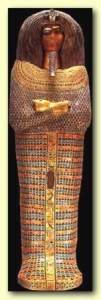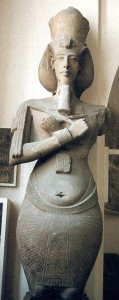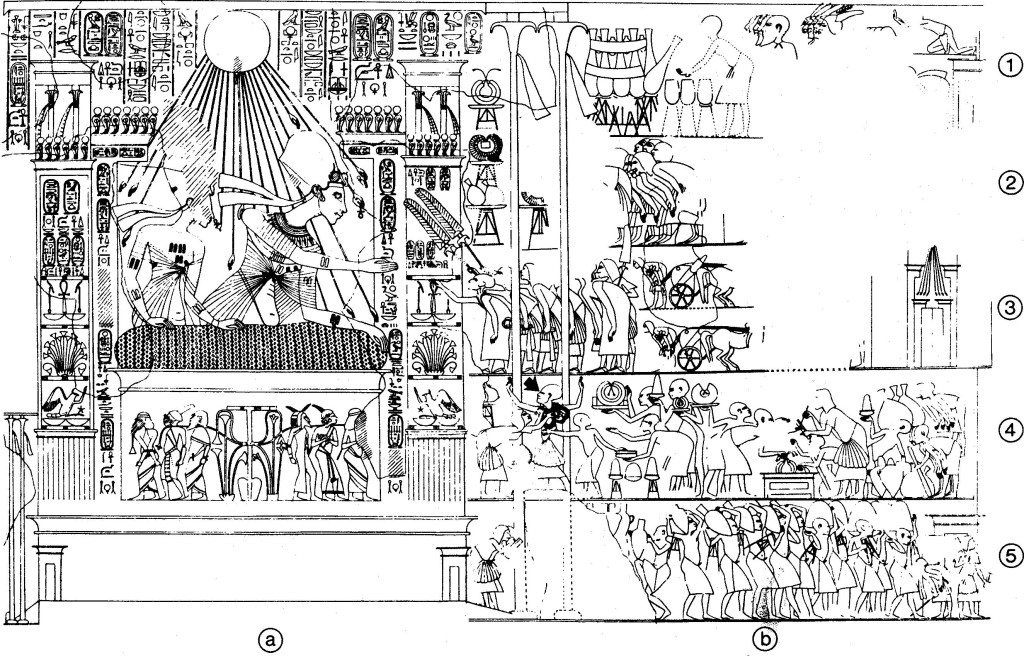 Sargon of Akkad was an upstart, a nobody, raised to power by the favour of a goddess—at least, according to the legends that both celebrated and rationalized his iffy background. But what if a would-be leader did not have to fudge his background to get respect? What if he were already considered to be the very next thing to a god, born at the very summit of the social pyramid? That was the case with Akhenaten of Egypt, the Heretic Pharaoh, and husband of the more famous Queen Nefertiti.
Sargon of Akkad was an upstart, a nobody, raised to power by the favour of a goddess—at least, according to the legends that both celebrated and rationalized his iffy background. But what if a would-be leader did not have to fudge his background to get respect? What if he were already considered to be the very next thing to a god, born at the very summit of the social pyramid? That was the case with Akhenaten of Egypt, the Heretic Pharaoh, and husband of the more famous Queen Nefertiti.
Move forward from Sargon by about a millennium, and westward by some eight hundred miles, to New Kingdom Egypt in the mid-14th century BC. This is the troubled Amarna period, a murky blip in pharaonic history, erased and forgotten for over three thousand years. Almost everything surrounding the enigmatic Akhenaten and his court is controversial, partly because the archaeological record for this period is more than usually fragmentary. This, in turn, is because the generations that followed Amarna made a savage effort to wipe out even the memory of this time, and particularly this personage. Inscriptions were chiseled out, king lists were altered, whole temples were dismantled, an entire city was left to ruin. At least three, maybe five, pharaohs became nonpersons.

Even so, a fascinating story can be pieced together from the scattered fragments. Here is the story as it is usually told. In a dazzling era of Egyptian prosperity and power, when the state god Amun ruled in Thebes, the hugely successful pharaoh Amenhotep III of the 18th dynasty was succeeded by his younger son Amenhotep IV. The new pharaoh started off fairly conventionally, but broke away within a few years from the worship of the numerous immemorial state gods, and defied the powerful Amun priesthood in Thebes. In place of Egypt’s diverse polytheism, he instituted the monotheistic worship of the sundisk, the Aten, which he considered to be the source of all life; and to better concentrate on this, he shifted himself and his court off to a stretch of barren desert about midway between the two traditional capitals, Memphis and Thebes, a place now called Amarna. In the course of his reign, he changed his name to honour the new god, desecrated the idols of the old faiths, and neglected the nation’s affairs to the point that Egypt’s prosperity and empire were threatened.
Then he died, giving rise to a shadowy six-year sequence of little-known pharaohs who scrabbled vainly to keep the new religion alive. Eventually the nine-year-old Tutankhamun was placed on the throne, and in his short reign, the court moved back to Thebes and the old gods were reestablished. After Tut’s untimely death and hasty burial, the throne was taken over by Ay, a high official of the old regime, who himself had a short reign and a suspicious death. Ay was followed by a commoner, a general named Horemhab, who systematically erased the previous reigns and the traces of the brief, heretical cult—in fact, wiping out the previous decades, as if he were the immediate successor of Amenhotep III.
Akhenaten’s departure from Egypt’s wild, lush polytheism caught the imagination of nineteenth-century scholars. At the time his story began to emerge in the mid-nineteenth century, scholars—who themselves were, of course, monotheists— considered monotheism to be superior by definition, and culturally more advanced (and truer) than the polytheism of heathen native cultures. Therefore, they came to see Akhenaten as a visionary, an innovator, a metaphysical philosopher tragically ahead of his time. Freud saw him as the inspiration for Moses, and the wellspring of what eventually became the Judeo-Christian-Islamic tradition; in fact, a net-search on Moses and Akhenaten will throw up an array of bizarre websites claiming that Akhenaten was Moses, and similar absurdities. Velikovsky saw him as Oedipus; other scholars as a forerunner of Christ. But are we really looking at a brave religious philosopher in Akhenaten, willing to risk all for the sake of getting closer to a single, personal god and a modern-style morality? Or, do we have—a messianic cult? In fact, there are distinct signs of the latter.
At the beginning of Akhenaten’s reign, he was still Amenhotep IV, a name linking him to Amun, the chief state god. He presided at the temple of Amun, paid respect to numerous other traditional deities, and was portrayed in the traditional idealized style. But very early in his regime, he ordered the construction of a vast temple at Karnak dedicated to the worship of a minor aspect of the sungod, the Aten, or sundisk—though he was not in fact the Aten’s first fan. The trend to expand the importance of the Aten had started with his grandfather, and continued with his father. Amenhotep IV, however, took things much, much farther.
 The temple featured huge statues of Amenhotep IV in a strange new-fangled guise: an androgynous style with long, exaggerated bone structure, a long face, swollen belly and hips, and feminine-looking breasts. This strange body has been taken several ways: either as an ideological distortion, exaggerating Akhenaten’s imperfections and feminine nature for religious reasons; or as a manifestation of some congenital pathology, for example Marfan’s or Froelich’s syndrome. ( The Egyptian royal family had also been interbreeding for generations, and the most famous Amarna mummy that has come down to us—Tutankhamun, very likely Akhenaten’s son—is loaded with congenital problems, including scoliosis, cleft palate, and club foot.)
The temple featured huge statues of Amenhotep IV in a strange new-fangled guise: an androgynous style with long, exaggerated bone structure, a long face, swollen belly and hips, and feminine-looking breasts. This strange body has been taken several ways: either as an ideological distortion, exaggerating Akhenaten’s imperfections and feminine nature for religious reasons; or as a manifestation of some congenital pathology, for example Marfan’s or Froelich’s syndrome. ( The Egyptian royal family had also been interbreeding for generations, and the most famous Amarna mummy that has come down to us—Tutankhamun, very likely Akhenaten’s son—is loaded with congenital problems, including scoliosis, cleft palate, and club foot.)
Starting in Year 5 of Amenhotep IV’s reign, dramatic developments altered the politicoreligious landscape. First, the king changed his name from Amenhotep to Akhenaten, in some readings the “mystical spirit, or akh, of the Sundisk”—signifying a claim to be the personification on Earth of the Aten. Second, he began his attack on the state cult of Amun, although (contrary to popular belief) he did not try to wipe out the rest of the vast pantheon—only Amun and Amun’s close associates. In fact, technically, the Amarna period was henotheistic rather than monotheistic.
Third, he upped stakes and moved the royal court to a brand-new purpose-built city in the middle of nowhere: Akhetaten, the “Horizon of the Sundisk,” the site now known as Amarna. It was an amazing place, springing up out of bare desert in only a couple of years, like a gold-rush town: huge palaces and huger temples, open to the sky, unlike the closed-in standard temples dedicated to the older gods. It was a stunning achievement—but there was a dark side.
The workmen building the tombs and temples in this boondocks royal city were underfed and overworked in a way not often seen in Egypt, according to the analysis of their physical remains. The beautiful mansions and grand suburbs may have looked fabulous, but little thought had been given to small matters like sanitation or drainage.
Further into the dark side, each of those grand houses held private shrines for worship – but the only gods shown there were the Aten (Sundisk) and the royal couple. Indeed, the only people ever shown directly worshipping the Aten were the royal couple and their immediate family, indicating that Akhenaten had set himself up as the sole intercessor between the supernatural and the mundane. This was a messianic move that put him somewhat beyond the pretensions of previous pharaohs. Everybody else was portrayed as bowing and scraping, and accepting gifts of gold necklaces from the royals – including the general who later became pharaoh, and so assiduously erased the traces of his erstwhile benefactor’s reign.
Overall, Amarna looks to me less like a brave, benign but ultimately doomed religious reformation, and more like an oppressive personality cult, centered around Akhenaten and Nefertiti, and not surviving them for very long. There are also indications that grave troubles in Egypt—possibly a plague, certainly problems with the empire and foreign relations—may have destroyed the credibility of the Aten cult, such that the government left to clean up the mess returned thankfully to the old traditions, and did their best to wipe out the memory of the failed messiah. Those are the bare bones of the story, which illustrates some common messianic-cultish motifs.
First, it is very common for a messianic character to lead the faithful into a wilderness, literal or metaphorical, where they—and he—can better be cut off from old ties, outside influences, and reality checks. Moses and Jim Jones, Manson and Brigham Young, are prime examples; L. Ron Hubbard, the messiah of Scientology, took Scientology to sea for many years on converted freighters. Etc. The move to Amarna was classic.
Second, there are distinct signs of megalomania and grandiosity. Megalomania may have been part of a pharaoh’s job description,  but Akhenaten seems to have taken it more seriously than most. As for grandiosity, Amarna was showy—but it was surface glamour on a large scale, built to showcase, not just the Sundisk, but the Sundisk’s prophet, Akhenaten. We see the same grandiosity in, for example, the tomb of the Qin emperor Shi Huang Di at Xian, another conquering messiah. In fact, messianic megalomania may be at the root of a good many wonders of the ancient world. As well, the egocentric focus of the cult is one that we will see again and again. Akhenaten may have worshipped the Aten, but the people were expected to worship him.
but Akhenaten seems to have taken it more seriously than most. As for grandiosity, Amarna was showy—but it was surface glamour on a large scale, built to showcase, not just the Sundisk, but the Sundisk’s prophet, Akhenaten. We see the same grandiosity in, for example, the tomb of the Qin emperor Shi Huang Di at Xian, another conquering messiah. In fact, messianic megalomania may be at the root of a good many wonders of the ancient world. As well, the egocentric focus of the cult is one that we will see again and again. Akhenaten may have worshipped the Aten, but the people were expected to worship him.
Third, we have deterioration: the cult leader moving further out of touch with reality, and further into delusions of grandeur and omnipotence, while things around him are otherwise falling apart. In this case, Akhenaten kept himself busy handing out gold necklaces and writing hymns to the Aten, and Egypt came very close to losing her empire.
Fourth, we see the consort, a not uncommon accessory: the opposite-sex soulmate of the messiah, and often a primary sexual  partner. Not all messiahs have them, but when they do, the consort may have almost as much power as the principal, and may be the only person the messiah defers to or depends on emotionally. Indeed, the messiah usually demands the same deference for his consort as he demands for himself. She may even try to assume control of the cult if the messiah goes out of the picture, and sometimes she succeeds. The beautiful Nefertiti was a classic consort, and we shall see many more, from Mother Divine and Madame X to David Berg’s “Maria”.
partner. Not all messiahs have them, but when they do, the consort may have almost as much power as the principal, and may be the only person the messiah defers to or depends on emotionally. Indeed, the messiah usually demands the same deference for his consort as he demands for himself. She may even try to assume control of the cult if the messiah goes out of the picture, and sometimes she succeeds. The beautiful Nefertiti was a classic consort, and we shall see many more, from Mother Divine and Madame X to David Berg’s “Maria”.
Fifth—and more speculatively—Amarna may reflect an episode of pathological transformation or apotheosis. Why did Amenhotep IV, a pharaoh more or less in the conventional mode, become the decidedly nonconformist Akhenaten? Standard explanations range from political (a desire to smash the power of the Amun priesthood) to mystical—a measured desire to get closer to a personal god. But perhaps the sudden escalation of change in Year 5 reflects a road-to-Damascus type of vision for the young king; a good candidate is his claim that the Aten itself directed him to the site of his new cult-city, a place where the sun rising over the eastern hills gave the illusion of the hieroglyph for “horizon”. Many messiahs appear to have received their missions, their egomania, and their charisma while ill with fever, in visions that sound suspiciously like cerebral events leading to certain kinds of temporal lobe damage: Wovoka, Caligula, Saul of Tarsus, Joan of Arc, even Adolf Hitler. In this connection, it is interesting that recent research does suggest a congenital temporal epilepsy syndrome running through the tightly interbred Egyptian royal family.
Next week: Moses



